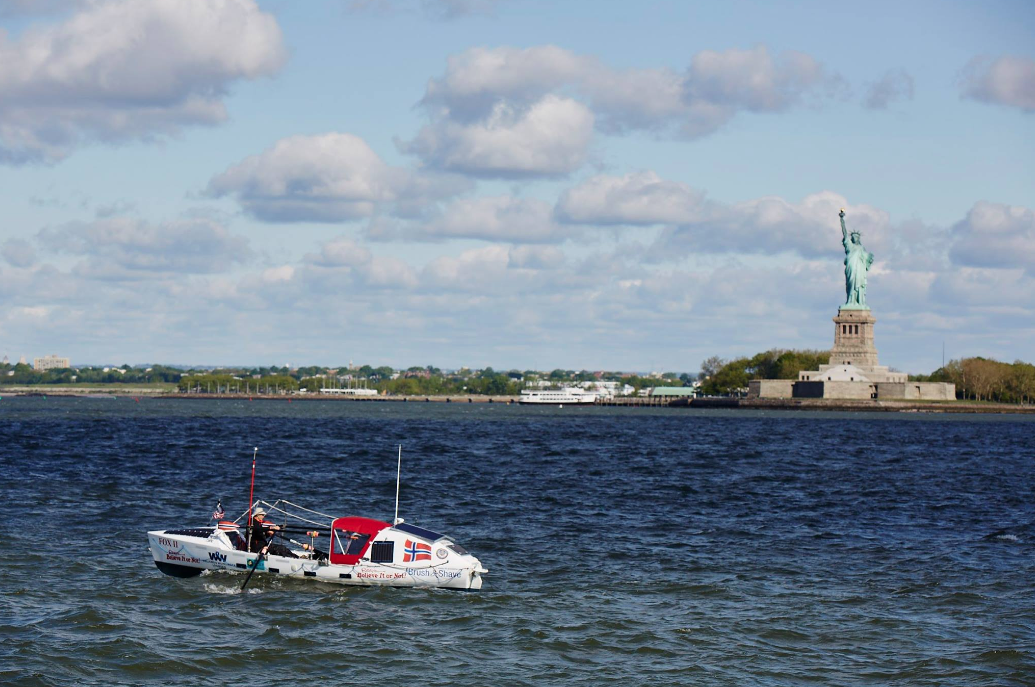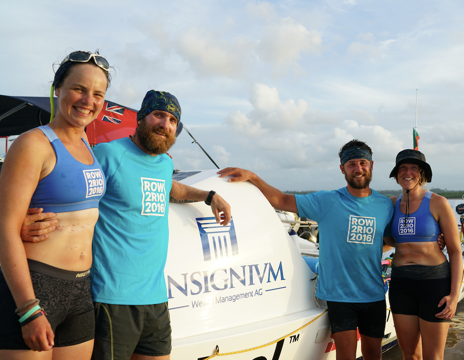Royal Navy duo complete dinghy world record attempt
Phil Slade and Mark Belamarich are now waiting for confirmation from the Guinness Book of Records after sailing in their dinghy from Plymouth to Portsmouth.
22 June
Leading Seaman Phil Slade and Mark Belamarich are waiting to find out from officials if they’ve done enough to beat the record for the ‘Longest Distance Sailed in a Double-Handed Dinghy’.
The pair passed the landmark Round Tower, Portsmouth at 8am and then met their families at the finish line on Whale Island on 17 June.
They sailed more than 300 nautical miles from Plymouth’s Royal Navy and Royal Marines Sail Training Centre Camber on Plymouth Sound to Whale Island.
This distance would set a new standard for the Guinness World Records.
The challenge, which began on 14 June, is in aid of the Royal Navy and Royal Marines Charity (RNRMC).
Speaking after finishing. Leading Seaman Slade said: “The challenge is great for Royal Navy and Royal Marines sailing, as well as the Royal Navy and Royal Marines Charity.”
He continued: “We believe in the charity, which is why we put ourselves out as far as we did. They look after our serving personnel, families and veterans, so it is great to raise their profile. We’re still hoping to raise the full amount of £5,000. We’ll be collecting at Armed Forces Day weekend with buckets on Plymouth Hoe.”
The dinghy was escorted by a yacht with a Guinness records observer team on board.
A spokesman on board said: “They deserve a lot of credit for persevering in a small boat for all this time and distance.”
The current record for the ‘Longest Distance Sailed in a Double-Handed Dinghy’ is 300 nautical miles.
To beat it, the pair sailed a 320 nautical mile route which involved a night-time crossing of the English Channel to France in their unmodified basic 14-foot Bosun Class dinghy.
To find out whether they have achieved a new World Record, the duo face an agonising wait until their GPS and other tracking equipment can be verified by official sources.
Asked about any doubts in completing the challenge, Belamarich said: “At one stage we were definitely panicking – no wind and 45 miles from Portsmouth… I was worried we would just drift. We had to put everything up to catch the wind.”
He added: “It was a great challenge but physically demanding. We didn’t drink a lot of water and there was a bit of boredom at times but we didn’t fight! There were stages where we thought we wouldn’t make it.”
In 1964, Frank Dye, along with crew member, Bill Brockbank, sailed the 650 nautical miles between Scotland and the Faroe Islands and across the Norwegian Sea to Norway.
16 June
Royal Navy Leading Seaman Phil Slade and Mark Belamarich, who works for the Ministry of Defence, were due to arrive in Portsmouth at midday, today, 16 June.
However, light winds have slowed their good progress and they are now expected tomorrow morning after three nights at sea.
The pair are still on course to have sailed more than 300 nautical miles from Plymouth’s Royal Navy and Royal Marines Sail Training Centre Camber on Plymouth Sound to Whale Island in Portsmouth.
This distance would set a new standard for the Guinness Book of Records.
The challenge is in aid of the Royal Navy and Royal Marines Charity (RNRMC).
The dinghy is being escorted by a yacht with a Guinness Book of Records observer team on board.

Phil Slade and Mark Belamarich attempting to break the record. Credit : Joel Rouse
A spokesman on board said: “The dinghy has been hit by a lull in winds. This has put back their estimated arrival in Portsmouth. They are expected to arrive early tomorrow morning – possibly about 8am, though that is only an estimate.”
“The winds are picking up a little. The sailors’ morale is high and they are doing well. We look forward to seeing them finish their challenge”, concluded the spokesman.
The sailors have reacted to the drop in wind strength by taking a more direct route further off the South Coast to try and catch stronger winds.
The current record for the ‘Longest Distance Sailed in a Double-Handed Dinghy’ is 555.6 kilometres, which is 300 nautical miles.
To beat it, Slade and Belamarich are sailing a 320 nautical mile route which involves a night time crossing of the English Channel to France in an unmodified basic 14-foot Bosun Class dinghy.
The pair left Plymouth on 14 June.
14 June
Royal Naval sailor, Leading Seaman Phil Slade and Ministry of Defence employee, Mark Belamarich set off from Plymouth at just after 3pm on 14 June.
The pair plan to sail to Portsmouth, continually, day and night, in an attempt to break the record for the longest distance sailed in a double handed dinghy.
They delayed their departure from Plymouth’s Royal Navy and Royal Marines Sail Training Centre Camber on Plymouth Sound by a day due to weather conditions.
The dinghy sailors hope to reach Whale Island in Portsmouth in about 60 hours, depending on winds and tides.
The current record for the Longest Distance Sailed in a Double Handed Dinghy is 555.6 kilometres, around 300 nautical miles.
To beat it, the pair have planned a route of 320 nautical miles which will take them around 64 hours at 5 knots.
It involves crossing the English Channel twice in a basic, unmodified 14-foot Bosun Class dinghy.
The challenge is in aid of the Royal Navy and Royal Marines Charity (RNRMC).
24 May
Royal Naval sailor, Leading Seaman Phil Slade and Ministry of Defence employee, Mark Belamarich are planning to sail in a Bosun dinghy between two naval bases.

Phil Slade and Mark Belamarich. Credit: Royal Navy
The pair are scheduled to leave the Royal Navy and Royal Marines Sail Training Centre, The Camber on Plymouth Sound at 8pm on 13 June. They are expected to arrive at Whale Island, Portsmouth at midday on 16 June.
In the process, they hope to beat the record for the longest distance sailed in a double handed dinghy. The current record is 300 nautical miles.
Slade and Belamarich are using an unmodified basic 14-foot Bosun dinghy – a robust stalwart of the UK armed forces sail training.
They have planned a route of 320 nautical miles which involves sailing via France. Depending on the weather, they believe this will take them 64 hours at 5 knots. They plan to sail day and night.
“We are doing this the hard way by taking a basic dinghy which most members of the armed forces who learn to sail will know well – the Bosun,” explained Slade.
“This is an old class of dinghy and we have only made three minor modifications for safety reasons – a magnetic compass, a radar reflector, and a light because we will be sailing in busy waters in the dark,” he noted.
Slade admitted that there are “obvious reasons why small boats don’t sail in the dark” as it “is potentially dangerous”.
He said: “Besides running the risk of being hit by larger vessel and sunk, we will also have the challenge of navigating without day time visual aids or radar.”
Slade added that dinghies are prone to capsizing in gusty winds.
While righting an upturned dinghy is “relatively easy” in daylight, he said “there are risks at night which include losing touch with each other and getting tangled with ropes and rigging which could end the challenge prematurely.”
Slade and Belamarich say they will be “relying heavily” on their sailing skills and experience.
“Basic sailing involves constantly adapting to clues on the water and the movement of the sail as to where the wind is shifting – but we will be denied all that, which all makes this an exciting and fulfilling challenge,” said Slade.
The challenge is also in aid of the Royal Navy and Royal Marines Charity.
Solo rower, 70, rescued from an Atlantic storm
Norwegian Stein Hoff, who was rowing from New York to England to recreate the journey of the first transatlantic row…
Pictures: Phaedo3 smashes trans-Atlantic record
Skipper Lloyd Thornburg and his crew believe they've broken the trans-Atlantic speed record between Bermuda and Plymouth. It still has…
Record breaking Row2Rio team land in Brazil
The Row2Rio team celebrated on 23 April as they landed in Brazil, having rowed 3,400 nautical miles across the Atlantic…












